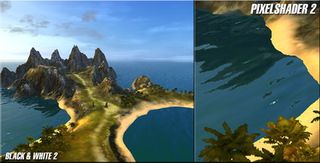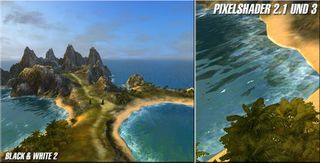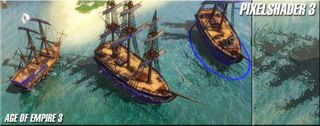New 3D Graphics Card Features in 2006
Differences Between PixelShader 2 And PixelShader 3
These days, it makes sense to distinguish the shader by its version number; anything lower than PixelShader 3 cannot display new graphics effects like HDR rendering, parallax mapping and transparent water. Among the graphics chips with PixelShader 3 are the complete Radeon X1000 series from ATI, and the Geforce 6 and Geforce 7 from Nvidia.
The most obvious differences in graphics quality between DirectX 8 and DirectX 9 are the increased brightness of light sources, and the improved 3D effects in stone and brickwork; PixelShader 3 also draws water more realistically. Waves have more details, and reflected shadows are distorted across the animated surface.
In Age of Empires III, the water appears transparent when the Very High setting is used, which invokes PixelShader 3; on the High setting (PixelShader 2 and 2.1) the effects are less impressive. Optimizing a game like Black & White 2 for ATI improves the representation of water with the PixelShader 2.1 as well.

With PixelShader 2, the sea lacks spray and transparency, and waves and reflections appear normal.

With PixelShader 3, the waves beating against the shore foam with spray, and the sea is transparent. Black & White 2 was optimized for ATI graphics cards, so the effects are also visible with PixelShader 2.1.

PixelShader 2 creates undulating movements and reflective surfaces. The shadows cast by objects are also overlaid on the surfaces.

PixelShader 3 makes the surface of the water transparent, with shadows that are reflected by the water and match the waves.
Stay on the Cutting Edge
Join the experts who read Tom's Hardware for the inside track on enthusiast PC tech news — and have for over 25 years. We'll send breaking news and in-depth reviews of CPUs, GPUs, AI, maker hardware and more straight to your inbox.
Current page: Differences Between PixelShader 2 And PixelShader 3
Prev Page Shader Effects, Continued Next Page Differences Between PixelShader 2 And PixelShader 3, ContinuedMost Popular

